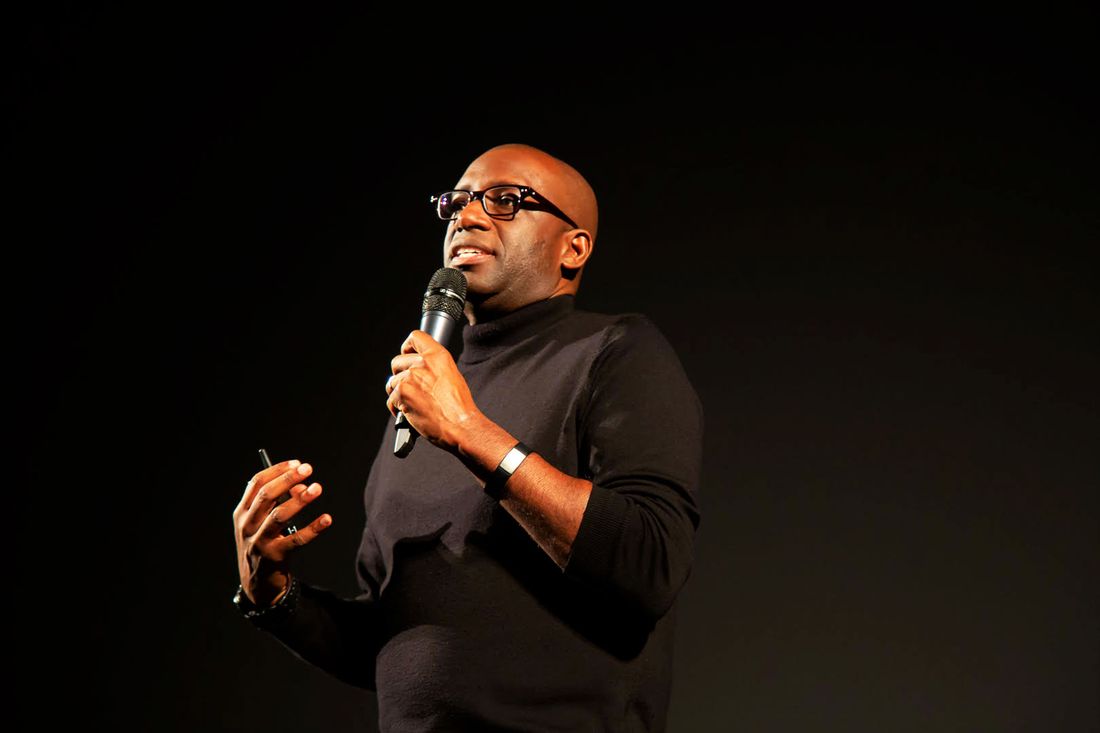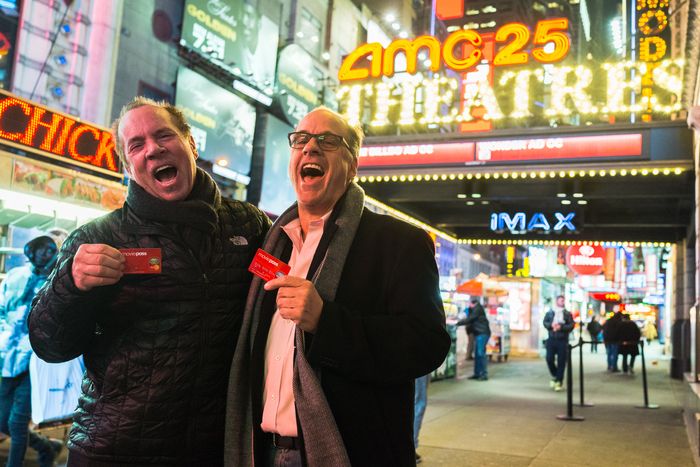
MoviePass knows about the memes. More specifically, Stacy Spikes, recently installed CEO of the embattled subscription-ticket service, has seen the response online to his Lincoln Center press conference last month announcing that the erstwhile “Netflix of cinemas” will be returning from the dead this summer. He’s acutely aware of the confusion surrounding one of MoviePass 2.0’s biggest innovations: a new feature called PreShow that will play ads on users’ phones in exchange for credits toward the purchase of movie tickets. PreShow’s facial-recognition technology tracks people’s eyeballs to ensure subscribers are really watching — as opposed to putting their phones on the sofa and walking away for a bio break — a process that conjures images of both Black Mirror and A Clockwork Orange.
For the most part, Spikes is okay with the ribbing. But he objects to a particular characterization in headlines like Vulture’s “MoviePass Is Back, and This Time, It’s Dystopian.” “We’re already in dystopia,” Spikes exclaims. “Think about it: All of your social media, your ability to communicate with the outside world, is ad supported. You have to watch stuff in order to get what you want. If we want to talk about dystopian — we’re standing in it!”
MoviePass exploded into public consciousness in 2017 by offering a movie-a-day subscription plan to participating theaters for the too-good-to-be-true rate of $9.95 a month. Since its founding in 2011, the company sought to shake up a movie-exhibition business dominated by large companies charging more and more, with little incentive to innovate the cinema-going experience. But the bigger play was always data harvesting: quantifying user spending patterns so that MoviePass could sell that info back to theater chains for a percentage of concessions sales and to movie studios for a cut of ticketing revenue. After growing from 20,000 paid subscribers to more than 3 million in a year — incurring the rancor of theater operators like AMC in the process — MoviePass buckled beneath its own ambitions. The company bled cash, with its parent company, Helios and Matheson Analytics, reporting a net loss of $150.8 million in 2017 and $329.3 million in 2018. It staggered from disaster to disaster — unannounced ticketing blackouts, random technological outages, massive amounts of user fraud, inability to pay fulfillment processors without emergency cash loans — until MoviePass couldn’t afford to pay for tickets anymore in 2019; it filed for Chapter 7 bankruptcy a year later.
Responsibility for that cascading sequence of fails fell upon MoviePass’s top executives: former CEO Mitch Lowe and chairman Ted Farnsworth. By then, Spikes, a former marketing exec for Miramax Films, October Films, and Sony Music who helped operate MoviePass as founding chief executive from 2011 until 2018, had been fired. During his relaunch presentation last month, Spikes projected a photograph of his two former colleagues holding MoviePass subscriber cards, their heads thrown back in laughter in manifest defiance of the industry pessimism that MoviePass faced. Yes, mistakes were made, the photo insinuated. No, they won’t be repeated.
During a recent conversation with Vulture, Spikes elucidated the ways MoviePass 2.0 will differ from its previous iteration, asserting the company will not only transcend existing skepticism but will thrive in a post-COVID era of streaming ascendancy, when theatrical moviegoing has become even more infrequent than it was at the company’s outset. He outlined an intent to build back better utilizing Web3 technology to enact a “consensual” customer relationship based around the accumulation and trade of crypto currency-like company credits, with subscribers effectively “selling” their attention rather than being foie gras-ed ad content against their wishes. Spikes insists that MoviePass’s “moonshot” goal of claiming 30 percent of the moviegoing market by 2030 is not just magical thinking. It is achievable if the company can make inroads with two separate but distinct constituencies: younger viewers who fled multiplexes for economically priced, subscription-based “walled gardens” like Netflix; as well as theater operators who, since the 2000s, have misguidedly recalibrated their business model to favor persuading customers to spend more on things like concessions and premium seating rather than convince them to come see movies at a regular clip. (See: AMC’s experiment in surge pricing for The Batman.)
Spikes characterizes the predicament as a kind of Information Age culture clash: A generation of viewers came of ticket-buying age just as the movie industry priced them out of the market. Today, they harbor no loyalty for cinemas; meanwhile, the theater chains are losing the ability to give patrons with any allegiances what they want. Then there is the divide in outlook between Tinseltown and Big Tech, a schism he describes by alluding to the 1982 sci-fi video-game thriller Tron. “Silicon Valley thinks in frequency. Hollywood thinks in, How much can I get that single ticket sold for?” the CEO says. “Remember Tron? They were always focused on cycles. I want to say, How many cycles did you get out of that person in a week, in a month, in a quarter, in a year? When you think like a computer, when you think like hardware, you think frequency of use.”
What MoviePass 1.0 succeeded in doing was pushing the country’s three major theater chains to either establish or enhance their own subscription ticketing programs — Regal Unlimited, Cinemark Movie Club, and AMC’s A-List — that reward customer loyalty with the kinds of discounts that promote further frequency of use. But 1.0’s extreme tactics, such as the sporadic inability to issue refunds or its penchant for expiring users’ account passwords to prevent ticket purchases, also left many subscribers feeling angry, disappointed, and generally jerked around. I ask Spikes why he finds it preferable to resurrect a company with a damaged reputation rather than leave it for dead. “The idea worked,” he says. “Fifty percent of theaters now have some form of what we started. They all laughed at us and said, ‘No one is going to do subscription.’ And now they all have it. But there’s still a huge swath of the movie industry” — i.e., smaller chains and independent cinema operators — “that can’t afford to go build out a multimillion-dollar subscription platform. If we can be that player, that’s half the market. So, hell yeah, I’ll take it.”
‘Your Attention Has Value and Should Be Controlled by You’
To be clear, relaunching MoviePass with PreShow as a component was not Spikes’s original plan. In fact, quite the opposite. Forced out by Helios and Matheson in early 2018 (for balking at Lowe’s decision to slash MoviePass’s subscription price from $30 to $9.95), Spikes’s unstated ambition for several years was to mount PreShow as a standalone rival to the company he had previously created. “We were actually going to see if we could get PreShow up and then create another MoviePass. But I had to wait. I had to do it in a way that wouldn’t violate the MoviePass patents — because I no longer owned my own patents.”
The idea behind PreShow: Madison Avenue spends around $11 billion a year on product placement in Hollywood films. PreShow took shape early on as a hypothetical: What if rather than trying to incept advertisements into a movie, there was some new system? One where advertisers would cover a percentage of ticket prices in exchange for a few minutes of a moviegoer’s attention? The app would require users to spend time watching ads in exchange for credit toward certain moviegoing experiences. Why not be totally upfront about the transaction?
“Your attention has value and should be controlled by you,” Spikes says. “So with PreShow we wanted to create the first technology that allows you to monetize your own attention and set a value exchange for that. This is decentralized. Instead of: I’m going to embed cookies, and I’m going to track everything you do, and I’m going to sell it, and I’m going to put that money back in my pocket; what we see is: I’m going to let you engage with the brand and monetize that.”
He uses the latest James Bond installment, No Time to Die, as a case study in how it should work. Rather than pay to have their brands quietly show up in scenes alongside Daniel Craig, the companies featured in that film — Heineken, Land Rover, Orlebar Brown, and Adidas among them — could pool, say, $20 million of their product-placement budget to pay for PreShow commercials instead. That money would cover a certain number of full or partial ticket purchases for PreShow subscribers, putting butts in seats and creating a supposedly deeper consumer engagement with the brands. The upshot, for Spikes: Both advertiser and consumer operate under total transparency. “Now [as an advertiser] I’ve tied myself into the movie even more than with the product placement,” Spikes says. “Now the consumer is directly relating to me. I’m getting to spend three minutes showing them a behind-the-scenes [feature] and talking to them. I can ask, Do you want to test drive a Land Rover?”
He began fundraising for PreShow around the same time Farnsworth and Lowe were establishing MoviePass’s infamous $300 million line of credit (they would burn through nearly half a billion dollars in two years). Spikes was “crestfallen” at the time. As he tells it, deep-pocketed investors were less likely to bankroll “diversity” founders like himself and MoviePass co-founder Hamet Watt. “The fact of the matter is we couldn’t get more capital,” says Spikes. “And Mitch and Ted were able to access capital. Lots of it. A light switch went on: Oh wait, there’s not Black people at the front of the company anymore? You need more money? Here.”
Enter B.K. Fulton. The founding chairman and chief executive of the media investment company Soulidifly Productions, and a former director of technology programs and policy for the National Urban League, Fulton was a longtime professional acquaintance of Spikes who had helped beta test MoviePass in its early days. He had missed out on investing in version 1.0 during a friends-and-family round of financing. A decade later, though, Fulton was curious about Spikes’s post-MP moves and invited him to lunch. The meeting concluded with Fulton offering a check for “a big number” to cover the cost of registering PreShow’s patent and Spikes crying at the table in relief.
“Many people get second chances,” Fulton explains. “Many people get two, three, and four chances, especially if they don’t look like us. And so what I decided to do was invest in him and his technology. I didn’t do it because he was Black. I didn’t do it because I was Black. I did it because it was good technology; it was a great idea.”
Fulton’s money would have helped make it possible for PreShow to compete with MoviePass, had the latter company not dropped out of competition altogether. “PreShow ended up buying MoviePass,” Spike explains. The process began, notably, with a movie. Last summer, the producer of an unfinished documentary about MoviePass (who asked not to be named in this story) informed Spikes that the company was up for sale in a Southern District of New York bankruptcy auction. Spikes, who had given up trying to regain control of the company, was shocked to discover several streaming services had dropped out of the bidding because the customer data of MoviePass’s 3 million users was not included in the deal. He put in a bid in the fall of 2021. “We had to sit there for almost a month. No one spoke against the purchase,” he recalls. “And the judge says, ‘I’m granting it back to Mr. Spikes.’”
Prior to his November 2021 purchase, the CEO commissioned anonymous polling data through Google and SurveyMonkey to gauge whether consumers had held space in their hearts for the beleaguered ticketing service. He was encouraged when respondents seemed able to distinguish between the benefits of membership and corporate mismanagement under Farnsworth and Lowe. “The brand was healthy and intact,” Spikes says. “Consumers never stopped talking about their love for MoviePass. They were able to separate out what was suboptimal behavior of some bad actors and what was an incredible brand that people loved.”
Now, he likens his odyssey with MoviePass to the career path of a certain turtleneck-wearing tech titan who was famously dismissed from the company he helped found only to triumphantly return as its CEO more than a decade later. “It was very much like when Steve Jobs went back to Apple,” Spikes says.
‘I Think We Just Need to Stop Talking About the Facial-Recognition Part’
During the company’s February 10 press conference, Spikes side-stepped any mention of how much MoviePass 2.0’s subscriptions are going to cost. A data crunch is currently underway to establish three tiers of pricing in anticipation of the service’s public rollout during popcorn-movie season this year. (No official launch date has been announced beyond “Summer 2022.”) Spikes says the platform will employ a frequent-flyer-like system that encourages users to build up, purchase, and roll over credits toward movie-ticket purchases. The digital currency can also be traded with other subscribers via blockchain technology in further fealty to decentralized, Web3 ideals. Just don’t expect the return of that $9.95 a month pricing plan. “I can tell you there’s a range,” says Spikes. “You don’t want to be above, say, 30 [dollars]. And you want something that maybe is also low as an entry point for a person who might go once or twice a month. So you want that ceiling and floor.”
The CEO insists now is as good a time as any to relaunch: the right moment to “catch the wave” of patrons returning to the multiplex, even as pandemic conditions (and industry apprehensions concerning ticket sales) have yet to fully abate. Over Zoom, he shares his screen with me, revealing some of his polling data: 91 percent of poll respondents say they would be interested in trying the products shown in PreShow, 97 percent say they “love this concept.” “This is a real number! Ninety-seven percent said they would use this service multiple times a week!” Spikes exclaims. “I think we just need to stop talking about the facial-recognition part and just give them the free-ticket part.”
Movie-industry executives polled by Vulture voiced a wait-and-see outlook. They aren’t opposed to the new MoviePass per se, but don’t feel compelled to support it until box-office returns come in. Some industry observers see reason for cautious optimism, but with plenty of asterisks. Shawn Robbins, chief analyst for BoxOffice Pro, points out that competition for the under-25 market’s entertainment dollars is already fierce; unlike MoviePass, Regal Unlimited and Cinemark Movie Club can sweeten their membership deals with discounted concessions. And there are services like Mubi Go pursuing art-house cinema membership programs. “Young audiences are at the heart of theatrical recovery, so I believe there is an openness to subscription services that’s the norm in the entertainment world right now,” he tells Vulture. “That said, price points and benefits are king.” (The National Association of Theater Owners declined to comment for this article.) Spikes says he is in the process of hatching deals with theater partners outside the big three chains.
“Somebody called MoviePass the ‘Christ brand’ because it got sacrificed,” Spikes concludes. “The very people that were killing us, saying, ‘You can’t let this happen,’ became the biggest subscribers, right? The Roman emperors all became Christians. Now the bottom 50 percent of theaters has to catch up. And if you get 15 percent at the top, it’s just simple numbers. If the industry shifts its thinking, you have something that’s attainable.”






